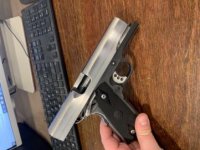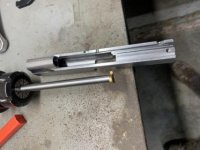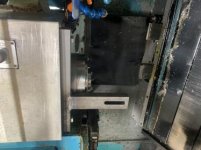Neil S.
Plastic
- Joined
- May 20, 2013
- Location
- Vermont, USA
Hello all,
I am looking for some tooling advise from the community.
As an Aerospace cnc job shop owner and firearm enthusiast, I have always wanted to produce a line of 1911 handguns. Well, the time has come and I have started a company called Sbardella Arms. We are currently tooling up a Matsuura MC800-VF with 4th axis to machine the slides from 4140 forgings. I have been running some setup pieces and have been getting some encouraging results, but the barrel hood clearance cuts and the locking lug cuts are giving me some chatter issues. Basically, I have to reach down almost 5" with a slot mill to make the cuts. I knew this would be the hardest part of the job, so I called Iscar and they recommended one of there multimaster tools, 0.618" diameter x 0.118" width, three flute with 3/8" carbide shank. Well, running test cuts this tool is not going to be rigid enough. They recommended 741 RPM, 1.1" FPM and 0.02" radial DOC, it sounded terrible and I'm supprised the tool didn't break. I used override to try to dial the RPM's down and the feed up a bit, but nothing seemed to work. That 3/8" shank 5" long is just not rigid enough.
So, iscar makes another shank that is 1/2" that tappers to 3/8" at the end and it looks like I will just barely have the clearance. Also, they have some 6 flute cutter heads that I might try.
But, before I invest in more expensive tooling that "might work", I thought I would ask if anyone has any advise? Anyone have experience machining 1911 slides? I have heard that some companies use a detachable support arm and just have M0's in the program to install/uninstall the arm for each slide, but that seems very sketchy to me and I would like to avoid that method. Any help would be appreciated!
-Neil
I am looking for some tooling advise from the community.
As an Aerospace cnc job shop owner and firearm enthusiast, I have always wanted to produce a line of 1911 handguns. Well, the time has come and I have started a company called Sbardella Arms. We are currently tooling up a Matsuura MC800-VF with 4th axis to machine the slides from 4140 forgings. I have been running some setup pieces and have been getting some encouraging results, but the barrel hood clearance cuts and the locking lug cuts are giving me some chatter issues. Basically, I have to reach down almost 5" with a slot mill to make the cuts. I knew this would be the hardest part of the job, so I called Iscar and they recommended one of there multimaster tools, 0.618" diameter x 0.118" width, three flute with 3/8" carbide shank. Well, running test cuts this tool is not going to be rigid enough. They recommended 741 RPM, 1.1" FPM and 0.02" radial DOC, it sounded terrible and I'm supprised the tool didn't break. I used override to try to dial the RPM's down and the feed up a bit, but nothing seemed to work. That 3/8" shank 5" long is just not rigid enough.
So, iscar makes another shank that is 1/2" that tappers to 3/8" at the end and it looks like I will just barely have the clearance. Also, they have some 6 flute cutter heads that I might try.
But, before I invest in more expensive tooling that "might work", I thought I would ask if anyone has any advise? Anyone have experience machining 1911 slides? I have heard that some companies use a detachable support arm and just have M0's in the program to install/uninstall the arm for each slide, but that seems very sketchy to me and I would like to avoid that method. Any help would be appreciated!
-Neil








